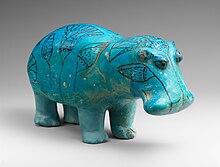Bradford Kelleher
Bradford Kelleher (July 31, 1920 – October 31, 2007) reinvented the
Early life
Bradford Kelleher was born on July 31, 1920, in
Kelleher returned to Yale after his departure from the military and began specializing in East Asian studies. He received his bachelor's degree in 1948.[1]
Metropolitan Museum of Art
Kelleher had initially hoped to pursue a career as a cartoon animator.[2] However, he was hired by the Metropolitan Museum of Art in 1949 after his father, William, ran into the museum's then director, Francis Henry Taylor, at the Century Club in New York City.[1]
Kelleher was first hired as a
Kelleher continued to supervise the Met store's expansion throughout the 1950s and 1960s. According to The New York Times, by the early 1960s Kelleher's store was selling a wide variety of items ranging from the traditional museum merchandise, such as books, to the less traditional, such as jewelry, prints and other collectibles.[1]

As the museum's merchandising business grew, Kelleher began to focus on producing high quality
Under Kelleher, the Met began to use its reproduction line as a way to support struggling artists and artisans.[1] For example, in 1959 the Met hired a Chinese refugee who set up a temporary art studio in the museum's basement creating traditional ink rubbings, which were then sold directly to visitors to the museum, and hiring an Italian potter who made reproductions of a Pennsylvania Dutch plate.[1]
Kelleher also supervised the building of reproduction
Kelleher was promoted to the museum's publisher in 1972.[1] He was further promoted to vice president of the Met in 1978.[2] Books published by Kelleher include Treasures from the Bronze Age of China: An Exhibition from the People's Republic of China (1980).[3] He retired in 1986, but continued to work with the Metropolitan Museum of Art as an active consultant until his death in 2007.[2] Two years after Kelleher's retirement, the Met opened its first satellite Met Store in Stamford, Connecticut, in 1988.[1]
The Met Store today
As of 2007, the Met Store and its
The Metropolitan Museum of Art is a
Death
Bradford Kelleher died on October 31, 2007, in Riverhead, New York.[1] He was survived by his wife, Mary.[1] The couple resided in both Manhattan and Cutchogue, New York.[1] Kelleher's death was announced by the Metropolitan Museum of Art, where he had worked for almost 60 years.[1]
References
- ^ a b c d e f g h i j k l m n o p q r s t u v w x y z aa ab ac ad ae af ag ah Kennedy, Randy (November 6, 2007). "Bradford Kelleher, Creator of Met's Store, Dies at 87". The New York Times. Retrieved December 4, 2007.
- ^ a b c d e f g h i j "Bradford Kelleher". Legacy.com. Associated Press. November 7, 2007. Retrieved December 4, 2007.
- ISBN 0-87099-230-9(1980)
External links
- The Met Store
- The Metropolitan Museum of Art
- New York Times: Bradford Kelleher, Creator of Met’s Store, Dies at 87
- Boston Globe: Bradford Kelleher, 87; turned museum gift shop into model
- Newsday: Bradford Kelleher, Met Museum vice president, dies
- Oral history interview with Bradford Kelleher, 1994 July 21- Aug. 17 from The Metropolitan Museum of Art Archives, New York.
